Nature Reserve Kyrgyzstan

Baiboosun is a nature reserve run by the local community. We at Baiboosun empower the people to conserve and protect the unique biodiversity of the Tien-Shan mountains
Scroll down to explore Baiboosun’s wildlife
Nature Reserve Kyrgyzstan
Baiboosun is a nature reserve run by the local community. We at Baiboosun empower the people to conserve and protect the unique biodiversity of the Tien-Shan mountains
Scroll down to explore Baiboosun’s wildlife












︎ A refuge for nature
![]()
![]()
![]()
![]()
![]()
![]()






Location: Kyrgyzstan
Baiboosun Gorge, Ton district, Issyk-Kul region
AREA: 14.000 hectares
public micro-reserve since 2018
Objective: preserve biodiversity & ecosystems
Baiboosun Gorge, Ton district, Issyk-Kul region
AREA: 14.000 hectares
public micro-reserve since 2018
Objective: preserve biodiversity & ecosystems
About Baiboosun
Our reserve is located in the Central Asian Republic of Kyrgyzstan. It is in the Issyk-Kul region, with an area of 14 thousand hectares and with mountain peaks reaching 4763 metres altitude. Our public nature reserve is a refuge for many endangered species included in the Red Book of Kyrgyzstan and the International Union for Conservation of Nature.
Our Mission
Our intention is to protect endangered species and ensure their preservation for the future generations. We hope to ease the conflict between humans and wildlife; promoting coexistence and contributing towards the maintenance of a healthy ecosystem.
Our reserve is located in the Central Asian Republic of Kyrgyzstan. It is in the Issyk-Kul region, with an area of 14 thousand hectares and with mountain peaks reaching 4763 metres altitude. Our public nature reserve is a refuge for many endangered species included in the Red Book of Kyrgyzstan and the International Union for Conservation of Nature.
Being one of the first initiatives in the country to create nature reserves run by the community, we play an important role in setting the standards for nature reserve conservation in the region, and specifically, snow leopard conservation in Central Asia.
Our MissionOur intention is to protect endangered species and ensure their preservation for the future generations. We hope to ease the conflict between humans and wildlife; promoting coexistence and contributing towards the maintenance of a healthy ecosystem.
We work by combining ecologically responsible activities with focused conservation efforts, to ensure the preservation of our local habitats while inspiring others to share our passion for nature and wildlife.
︎ A refuge for nature
![]()
![]()
![]()
![]()
![]()
![]()






Location: Kyrgyzstan
Baiboosun Gorge, Ton district, Issyk-Kul region
AREA: 14.000 hectares
public micro-reserve since 2018
Objective: preserve biodiversity & ecosystems
Baiboosun Gorge, Ton district, Issyk-Kul region
AREA: 14.000 hectares
public micro-reserve since 2018
Objective: preserve biodiversity & ecosystems
About Baiboosun
Our reserve is located in the Central Asian Republic of Kyrgyzstan. It is in the Issyk-Kul region, with an area of 14 thousand hectares and with mountain peaks reaching 4763 metres altitude. Our public nature reserve is a refuge for many endangered species included in the Red Book of Kyrgyzstan and the International Union for Conservation of Nature.
Our Mission
Our intention is to protect endangered species and ensure their preservation for the future generations. We hope to ease the conflict between humans and wildlife; promoting coexistence and contributing towards the maintenance of a healthy ecosystem.
Our reserve is located in the Central Asian Republic of Kyrgyzstan. It is in the Issyk-Kul region, with an area of 14 thousand hectares and with mountain peaks reaching 4763 metres altitude. Our public nature reserve is a refuge for many endangered species included in the Red Book of Kyrgyzstan and the International Union for Conservation of Nature.
Being one of the first initiatives in the country to create nature reserves run by the community, we play an important role in setting the standards for nature reserve conservation in the region, and specifically, snow leopard conservation in Central Asia.
Our MissionOur intention is to protect endangered species and ensure their preservation for the future generations. We hope to ease the conflict between humans and wildlife; promoting coexistence and contributing towards the maintenance of a healthy ecosystem.
We work by combining ecologically responsible activities with focused conservation efforts, to ensure the preservation of our local habitats while inspiring others to share our passion for nature and wildlife.
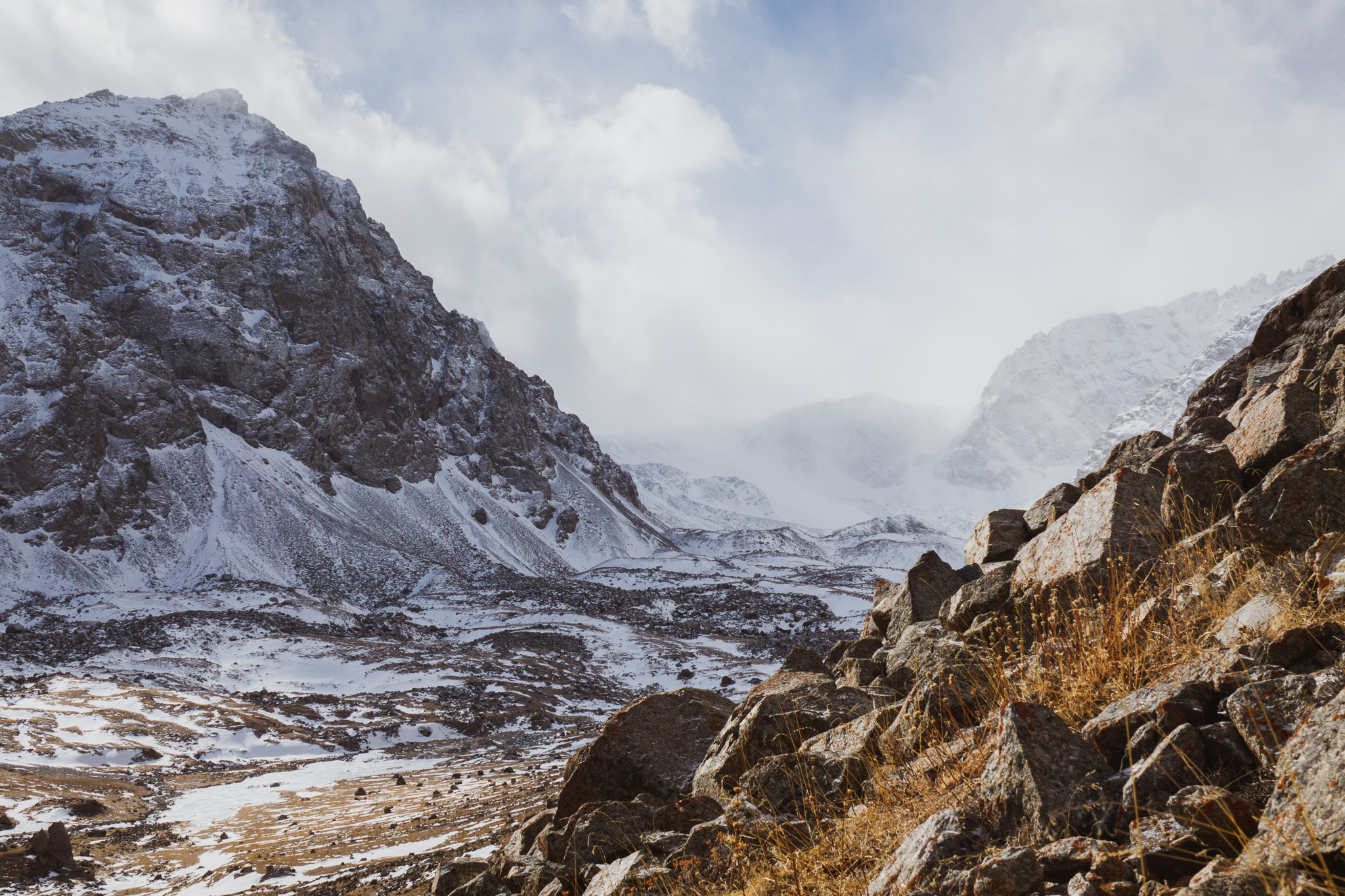
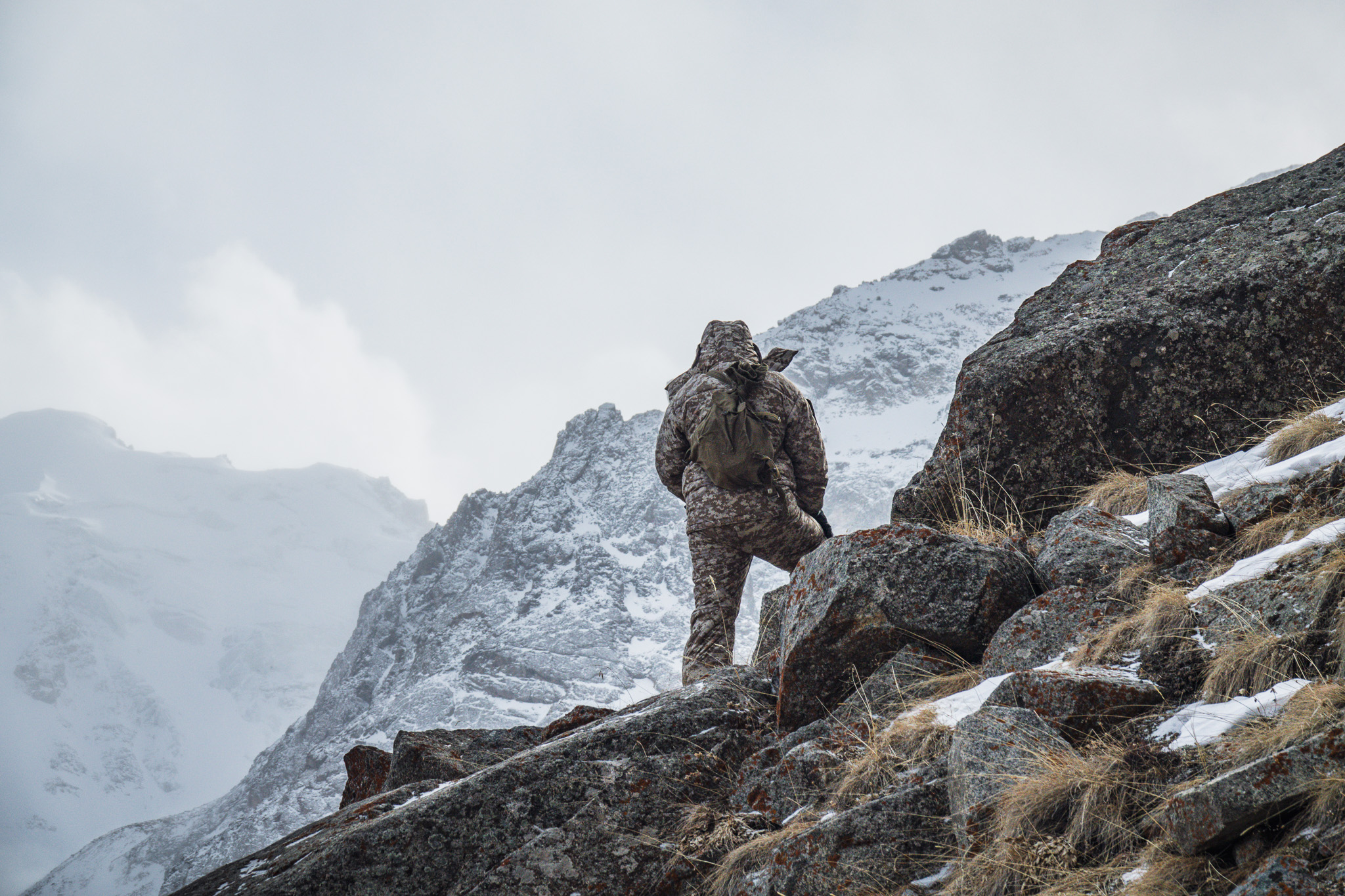
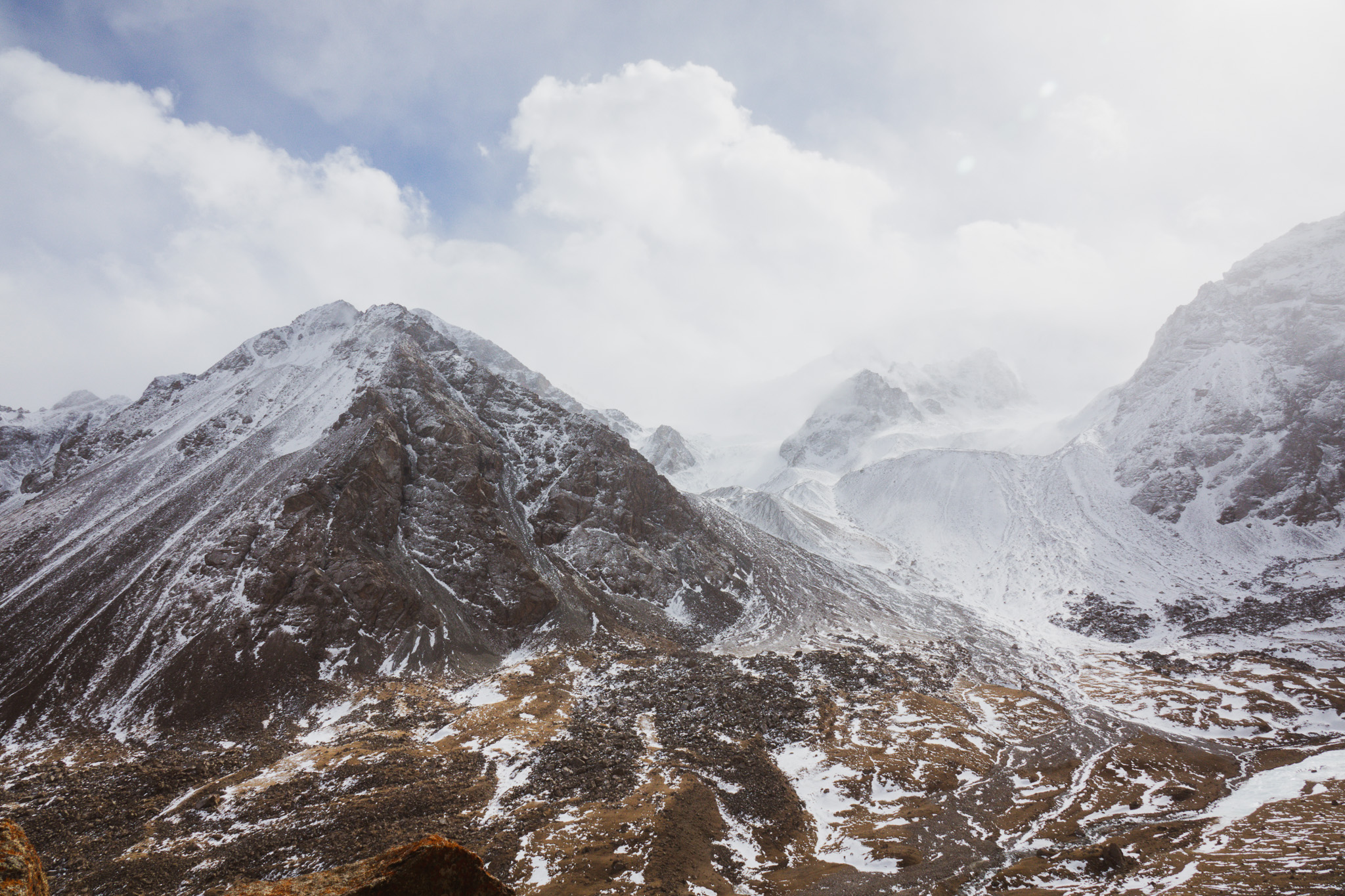
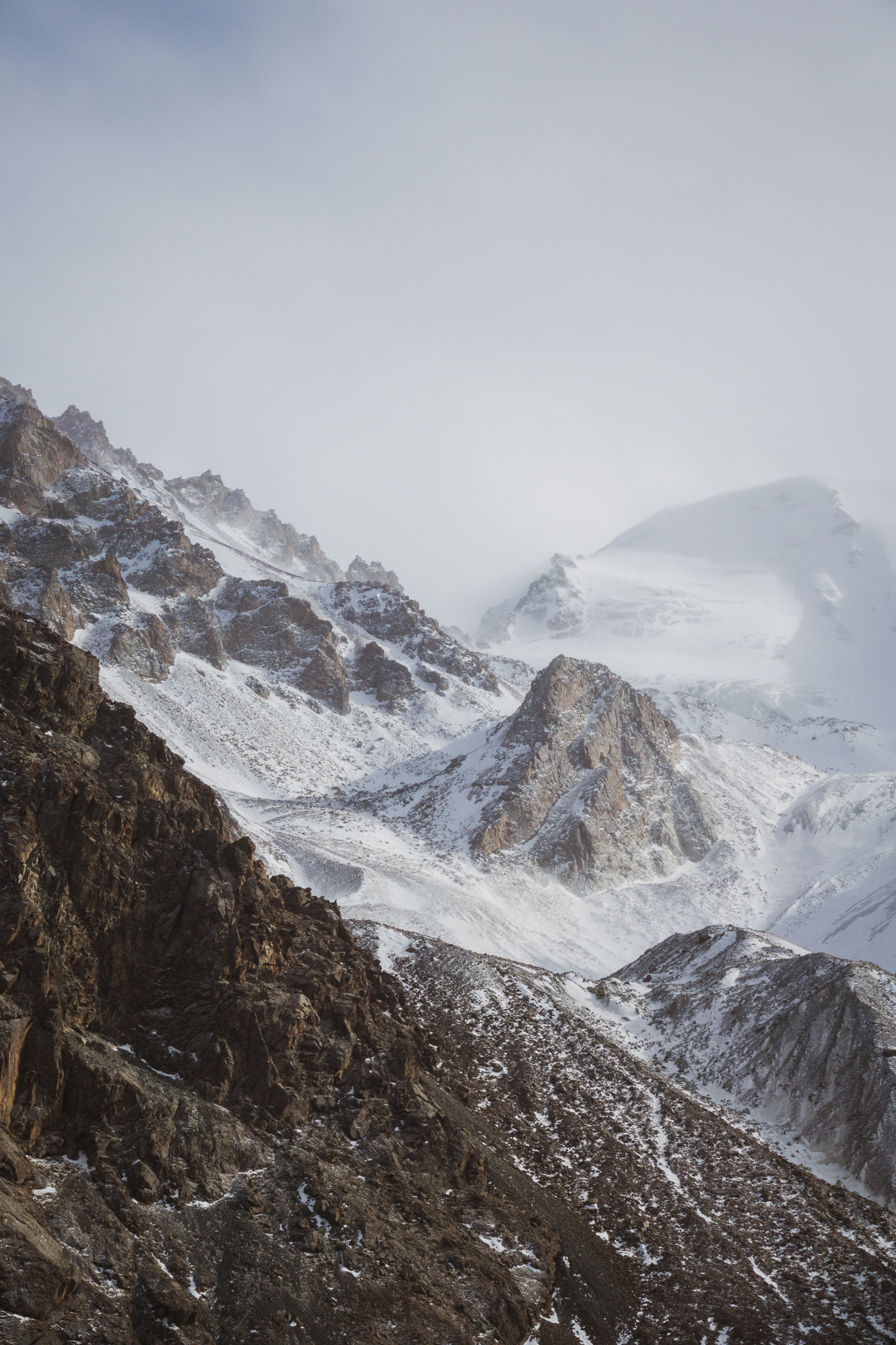

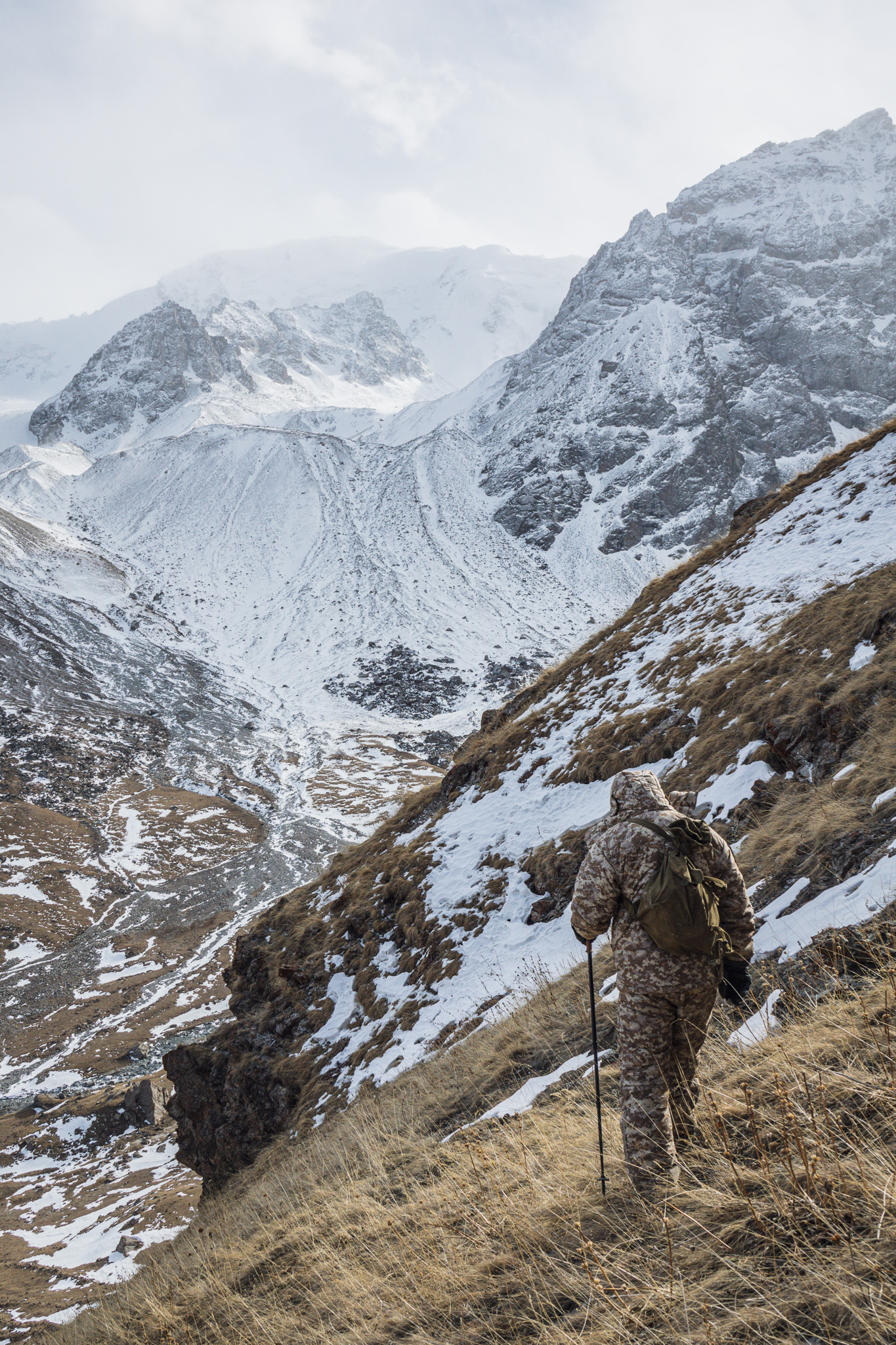
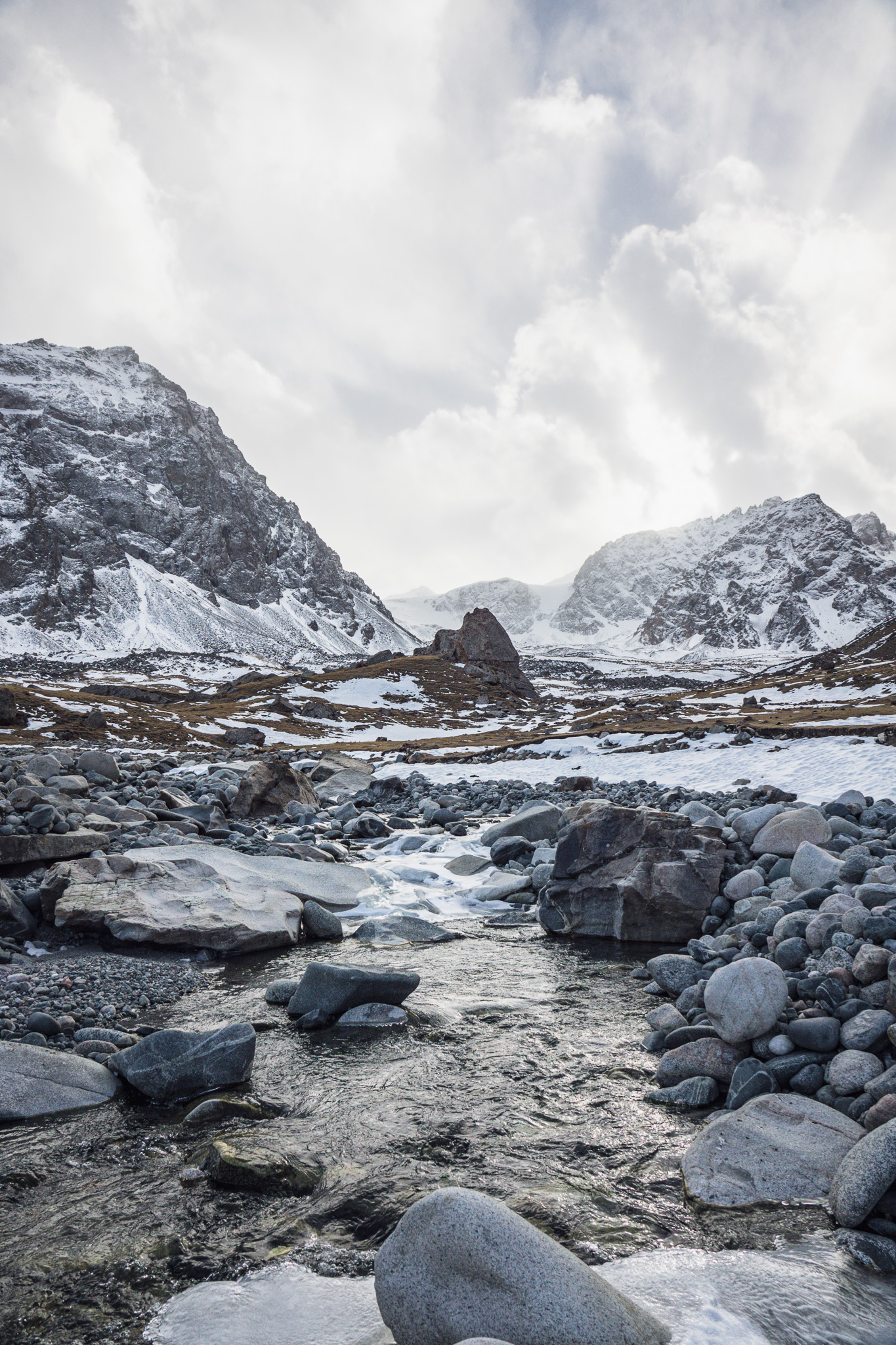
Kyrgyzstan and the snow leopard
︎ The grey ghost
![]()
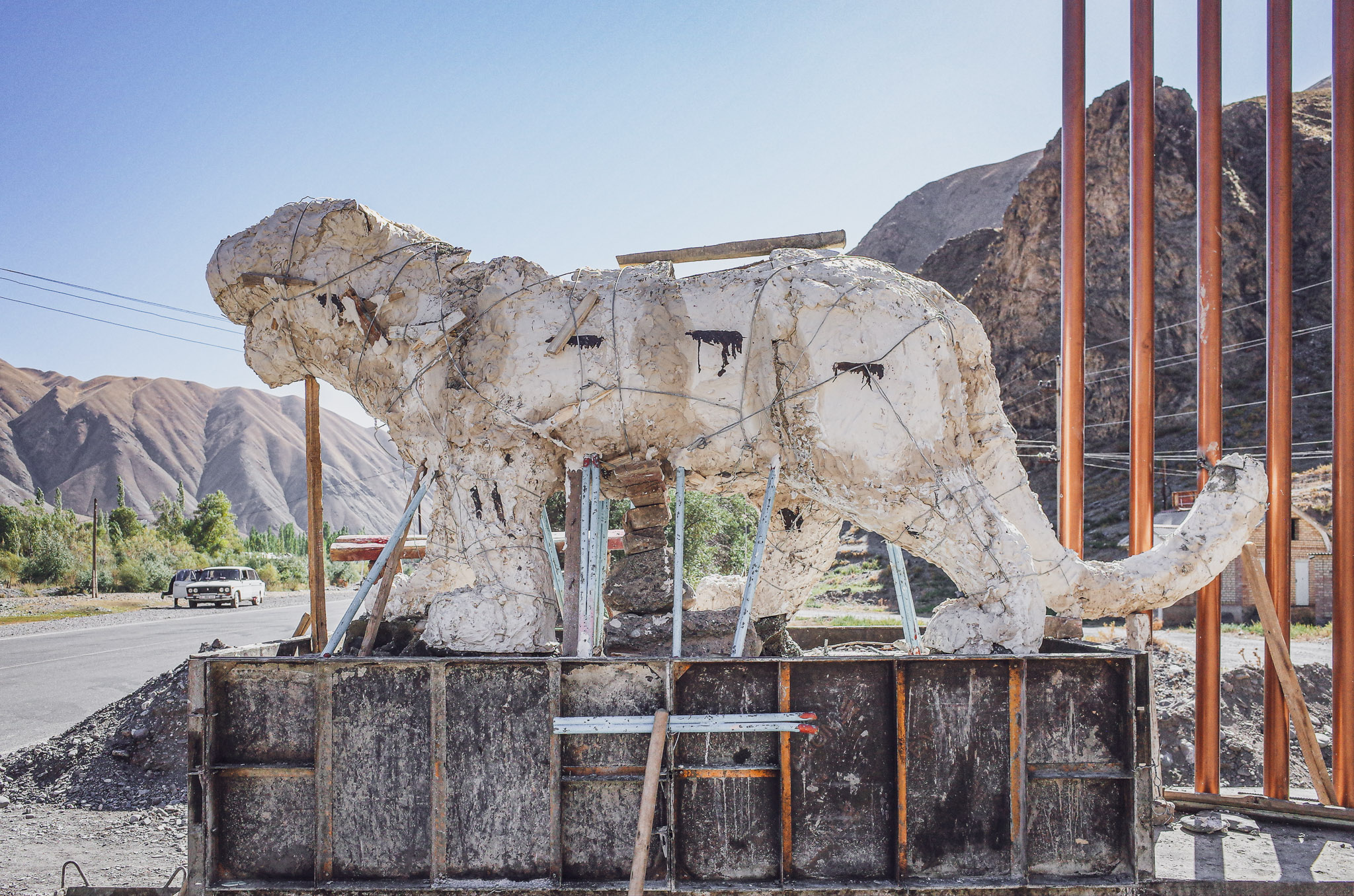
A recurrent scene by Kyrgyzstan roads. New statue of a snow leopard being cast in Naryn region
The snow leopard range
The snow leopard Panthera Uncia is the smallest and rarest of the so-called ‘big cats’ from the genus Panthera. The estimated population of snow leopards remaining in the wild is as few as 3500 to 6500. Their elusive behaviour and expansive habitats have made it difficult to estimate their population size accurately. The majority are thought to be found in Kyrgyzstan and Tajikistan.
Popular Culture
The snow leopard Panthera Uncia is the smallest and rarest of the so-called ‘big cats’ from the genus Panthera. The estimated population of snow leopards remaining in the wild is as few as 3500 to 6500. Their elusive behaviour and expansive habitats have made it difficult to estimate their population size accurately. The majority are thought to be found in Kyrgyzstan and Tajikistan.
The Tien-Shan and Pamir mountain ranges are among the highest in the world. These environments are ideal living conditions for the preferred prey of the snow leopard. Snow leopards act as regulators of prey populations within their habitat, and therefore, the ensuring of their well-being would ensure the stability of the whole ecosystem.
Popular CultureSince time immemorial, Kyrgyz people have regarded the snow leopard as a sacred animal and protector of the Kyrgyz warriors. It is no coincidence that the first leader of the Kyrgyz received the name Barsbek, which means ruler of the leopards. Barsbek was a hero who lived in the 7th century AD and united the Kyrgyz people, enabling them to maintain their independence against external enemies. Unfortunately, the snow leopard is now losing its sacred value.
References:
United Nations Environment Programme and GRID- Arendal (2020). Getting Climate-Smart with the Snow Leopard in Central Asia: A Species and Climate Change Brief for the Vanishing Treasures Programme. Nairobi: United Nations Environment Programme.
︎ The grey ghost
![]()

A recurrent scene by Kyrgyzstan roads. New statue of a snow leopard being cast in Naryn region
The snow leopard range
The snow leopard Panthera Uncia is the smallest and rarest of the so-called ‘big cats’ from the genus Panthera. The estimated population of snow leopards remaining in the wild is as few as 3500 to 6500. Their elusive behaviour and expansive habitats have made it difficult to estimate their population size accurately. The majority are thought to be found in Kyrgyzstan and Tajikistan.
Popular Culture
The snow leopard Panthera Uncia is the smallest and rarest of the so-called ‘big cats’ from the genus Panthera. The estimated population of snow leopards remaining in the wild is as few as 3500 to 6500. Their elusive behaviour and expansive habitats have made it difficult to estimate their population size accurately. The majority are thought to be found in Kyrgyzstan and Tajikistan.
The Tien-Shan and Pamir mountain ranges are among the highest in the world. These environments are ideal living conditions for the preferred prey of the snow leopard. Snow leopards act as regulators of prey populations within their habitat, and therefore, the ensuring of their well-being would ensure the stability of the whole ecosystem.
Popular CultureSince time immemorial, Kyrgyz people have regarded the snow leopard as a sacred animal and protector of the Kyrgyz warriors. It is no coincidence that the first leader of the Kyrgyz received the name Barsbek, which means ruler of the leopards. Barsbek was a hero who lived in the 7th century AD and united the Kyrgyz people, enabling them to maintain their independence against external enemies. Unfortunately, the snow leopard is now losing its sacred value.
References:
United Nations Environment Programme and GRID- Arendal (2020). Getting Climate-Smart with the Snow Leopard in Central Asia: A Species and Climate Change Brief for the Vanishing Treasures Programme. Nairobi: United Nations Environment Programme.
Challenges of conservation in the Tien-Shan mountains
︎ Endangered species
![]()

Threatened by climate change and poachers, the big cats are endangered, with only an estimated 3500 to 6500 left in the world
Human-wildlife conflict
Snow leopards and humans share the same landscapes, and with that comes certain complications. Livestock compete with prey for valuable grasslands which can lead to habitat degradation, and spur human wildlife conflict.
Threatened habitat
There are also some indirect impacts on the snow leopard driven by human activities, but also by climate change. In Central Asia, livestock is likely to roam at higher altitudes and create competition for resources with local wildlife, as evidenced in other parts of the snow leopard range.
Snow leopards and humans share the same landscapes, and with that comes certain complications. Livestock compete with prey for valuable grasslands which can lead to habitat degradation, and spur human wildlife conflict.
Potentially, livestock attacks from snow leopards could increase in the future due to a reduction in wild prey availability, or livestock moving into snow leopard habitats. This, in turn, could have an impact on farmers’ livelihoods, and result in increased retaliatory killing.
Threatened habitatThere are also some indirect impacts on the snow leopard driven by human activities, but also by climate change. In Central Asia, livestock is likely to roam at higher altitudes and create competition for resources with local wildlife, as evidenced in other parts of the snow leopard range.
Poaching has also become a practice of powerful individuals. Trophy hunting of certain prey species is permitted by law in Kyrgyzstan and is regulated by quotas but can also lead to the capture of snow leopards for illegal trade.
References:
Guardians of the headwaters II: biodiversity, water and climate in six Snow Leopards landscapes. WWF Technical Report 2017.
United Nations Environment Programme and GRID- Arendal (2020). Getting Climate-Smart with the Snow Leopard in Central Asia: A Species and Climate Change Brief for the Vanishing Treasures Programme. Nairobi: United Nations Environment Programme.
︎ Endangered species
![]()

Threatened by climate change and poachers, the big cats are endangered, with only an estimated 3500 to 6500 left in the world
Human-wildlife conflict
Snow leopards and humans share the same landscapes, and with that comes certain complications. Livestock compete with prey for valuable grasslands which can lead to habitat degradation, and spur human wildlife conflict.
Threatened habitat
There are also some indirect impacts on the snow leopard driven by human activities, but also by climate change. In Central Asia, livestock is likely to roam at higher altitudes and create competition for resources with local wildlife, as evidenced in other parts of the snow leopard range.
Snow leopards and humans share the same landscapes, and with that comes certain complications. Livestock compete with prey for valuable grasslands which can lead to habitat degradation, and spur human wildlife conflict.
Potentially, livestock attacks from snow leopards could increase in the future due to a reduction in wild prey availability, or livestock moving into snow leopard habitats. This, in turn, could have an impact on farmers’ livelihoods, and result in increased retaliatory killing.
Threatened habitatThere are also some indirect impacts on the snow leopard driven by human activities, but also by climate change. In Central Asia, livestock is likely to roam at higher altitudes and create competition for resources with local wildlife, as evidenced in other parts of the snow leopard range.
Poaching has also become a practice of powerful individuals. Trophy hunting of certain prey species is permitted by law in Kyrgyzstan and is regulated by quotas but can also lead to the capture of snow leopards for illegal trade.
References:
Guardians of the headwaters II: biodiversity, water and climate in six Snow Leopards landscapes. WWF Technical Report 2017.
United Nations Environment Programme and GRID- Arendal (2020). Getting Climate-Smart with the Snow Leopard in Central Asia: A Species and Climate Change Brief for the Vanishing Treasures Programme. Nairobi: United Nations Environment Programme.
Baiboosun unique biodiversity heritage
Baiboosun unique biodiversity heritage
︎ Research studies
![]()

The territory of Baiboosun has a high level of diversity of flora and fauna
Wildlife in Baiboosun
Back in 2019, a team of scientists from the National Academy of Sciences of Kyrgyzstan conducted an expedition in Baiboosun reserve and confirmed a high level of biodiversity. Snow leopards and 17 other species of mammals which are included in the Red Book of Kyrgyzstan were recorded. In addition, 60 species of birds (of which 6 species are included in the Red Book of Kyrgyzstan and the International Union for Conservation of Nature) and over 500 species of plants were recorded.
Back in 2019, a team of scientists from the National Academy of Sciences of Kyrgyzstan conducted an expedition in Baiboosun reserve and confirmed a high level of biodiversity. Snow leopards and 17 other species of mammals which are included in the Red Book of Kyrgyzstan were recorded. In addition, 60 species of birds (of which 6 species are included in the Red Book of Kyrgyzstan and the International Union for Conservation of Nature) and over 500 species of plants were recorded.
Mountains are hugely important for biodiversity: about half of the world’s biodiversity hotspots are located in highland or mountain regions. Some of the many reasons for this high biodiversity are: the varied physical terrains that have encouraged a high number of endemic species, low human population densities, and the convergence of several ecosystem boundaries in one place.
References:
Research report for the establishment of the Baiboosun public micro-reserve. Issyk-Kul region, Ton Disctrict. Institute of Biology of the National Academy of Sciences of the Kyrgyz Republic.
︎ Research studies
![]()

The territory of Baiboosun has a high level of diversity of flora and fauna
Wildlife in Baiboosun
Back in 2018, a team of scientists from the National Academy of Sciences of Kyrgyzstan conducted an expedition in Baiboosun reserve and confirmed a high level of biodiversity. Snow leopards and 17 other species of mammals which are included in the Red Book of Kyrgyzstan were recorded. In addition, 60 species of birds (of which 6 species are included in the Red Book of Kyrgyzstan and the International Union for Conservation of Nature) and over 500 species of plants were recorded.
Back in 2018, a team of scientists from the National Academy of Sciences of Kyrgyzstan conducted an expedition in Baiboosun reserve and confirmed a high level of biodiversity. Snow leopards and 17 other species of mammals which are included in the Red Book of Kyrgyzstan were recorded. In addition, 60 species of birds (of which 6 species are included in the Red Book of Kyrgyzstan and the International Union for Conservation of Nature) and over 500 species of plants were recorded.
Mountains are hugely important for biodiversity: about half of the world’s biodiversity hotspots are located in highland or mountain regions. Some of the many reasons for this high biodiversity are: the varied physical terrains that have encouraged a high number of endemic species, low human population densities, and the convergence of several ecosystem boundaries in one place.
References:
Research report for the establishment of the Baiboosun public micro-reserve. Issyk-Kul region, Ton Disctrict. Institute of Biology of the National Academy of Sciences of the Kyrgyz Republic.
Technology for conservation in the nature reserve
︎ Camera traps
![]()
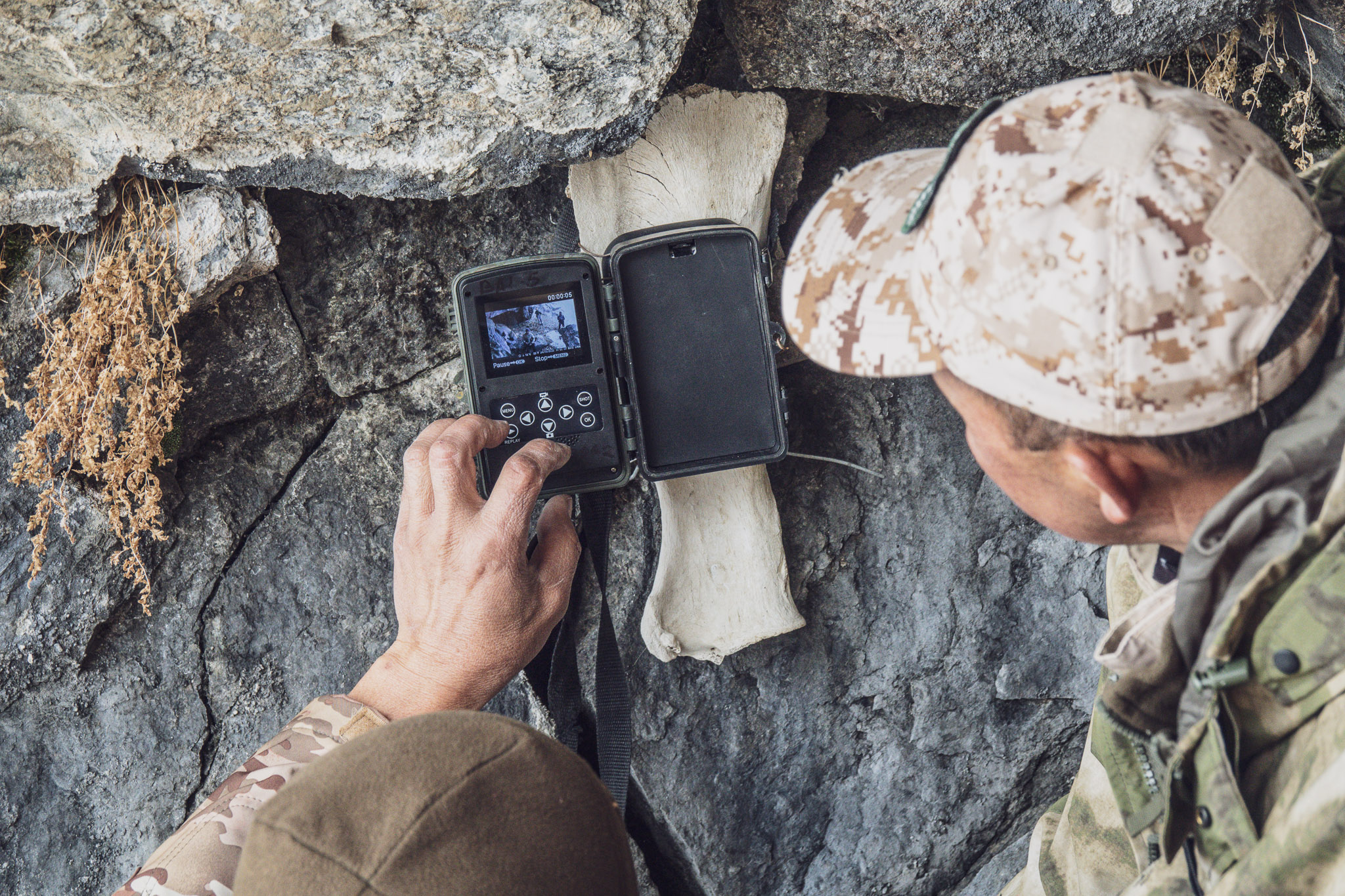
Team at Baiboosun servicing and collecting the footage taken by one of the camera traps in the reserve
Monitoring
Camera traps provide a window onto wildlife populations, relatively free from the disturbances caused by other sampling methods. They record data on species location, population sizes and the way that humans and wildlife species interact with each other.
Camera traps provide a window onto wildlife populations, relatively free from the disturbances caused by other sampling methods. They record data on species location, population sizes and the way that humans and wildlife species interact with each other.
New technologies allow camera traps to be left in the field to continuously watch an area of habitat for weeks or even months, recording the rarest events that occur in nature. This can include everything from the raiding of a bird nest by a predator, to a snow leopard patrolling its territory.
Camera traps are improving our understanding of the human impact on wildlife, and enabling more effective management of wildlife populations.
References:
Camera-trapping for conservation: a guide to best-practices. Oliver R. Wearn & Paul Glover-Kapfer. 2017. WWF Conservation Technology Series 1(1). WWF-UK, Woking, United Kingdom.
︎ Camera traps
![]()

Team at Baiboosun servicing and collecting the footage taken by one of the camera traps in the reserve
Monitoring
Camera traps provide a window onto wildlife populations, relatively free from the disturbances caused by other sampling methods. They record data on species location, population sizes and the way that humans and wildlife species interact with each other.
Camera traps provide a window onto wildlife populations, relatively free from the disturbances caused by other sampling methods. They record data on species location, population sizes and the way that humans and wildlife species interact with each other.
New technologies allow camera traps to be left in the field to continuously watch an area of habitat for weeks or even months, recording the rarest events that occur in nature. This can include everything from the raiding of a bird nest by a predator, to a snow leopard patrolling its territory.
Camera traps are improving our understanding of the human impact on wildlife, and enabling more effective management of wildlife populations.
References:
Camera-trapping for conservation: a guide to best-practices. Oliver R. Wearn & Paul Glover-Kapfer. 2017. WWF Conservation Technology Series 1(1). WWF-UK, Woking, United Kingdom.
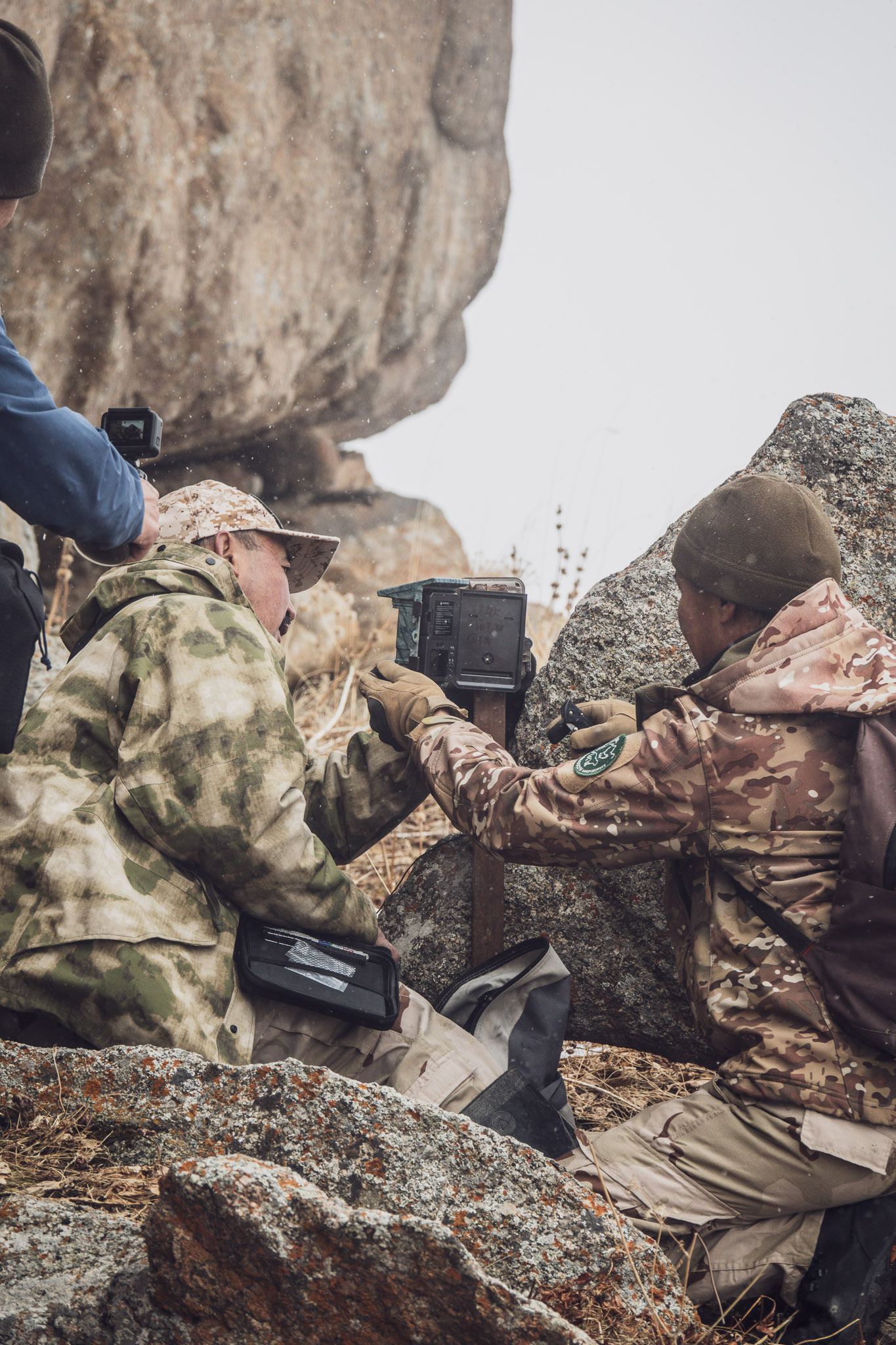
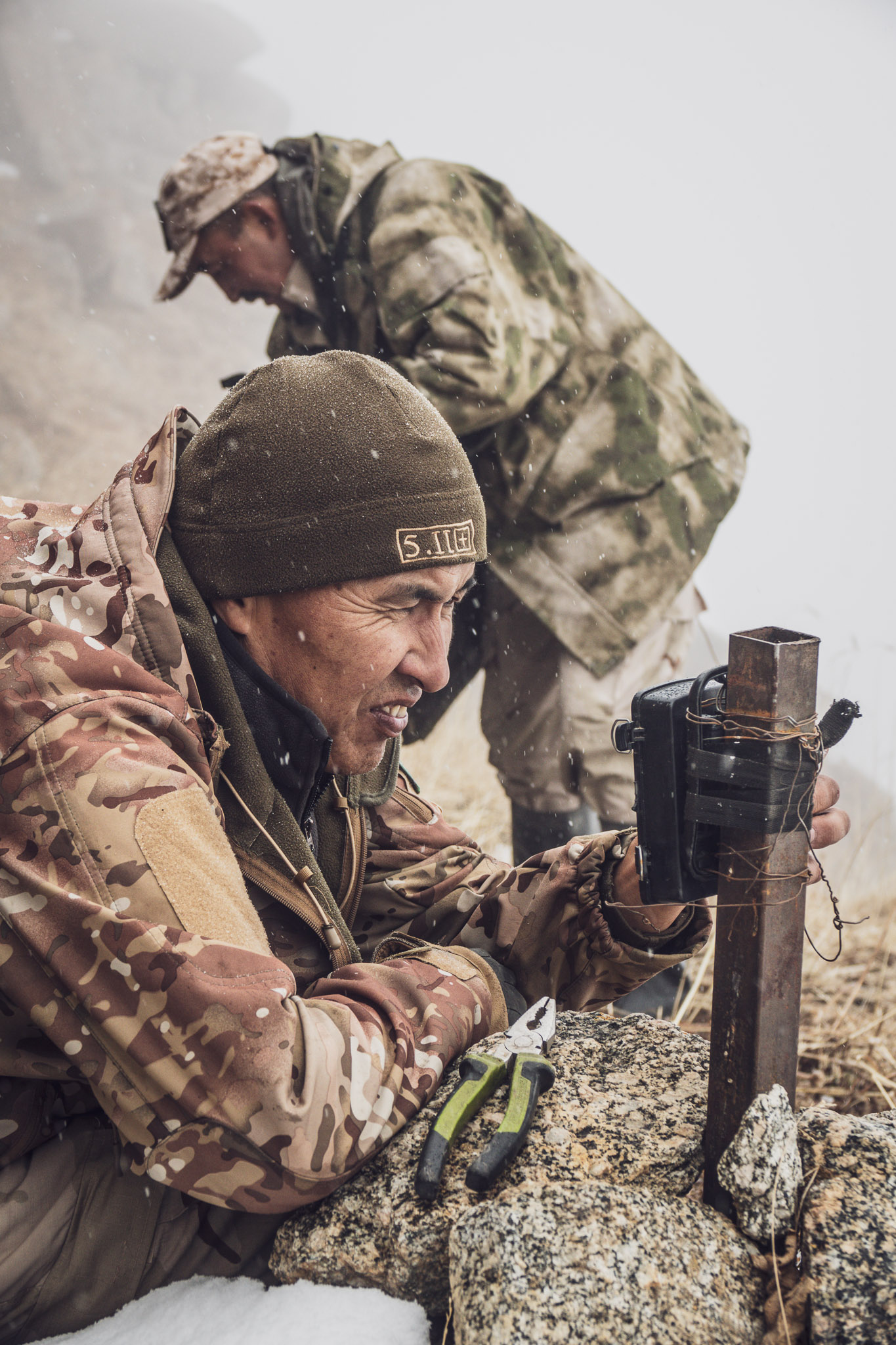

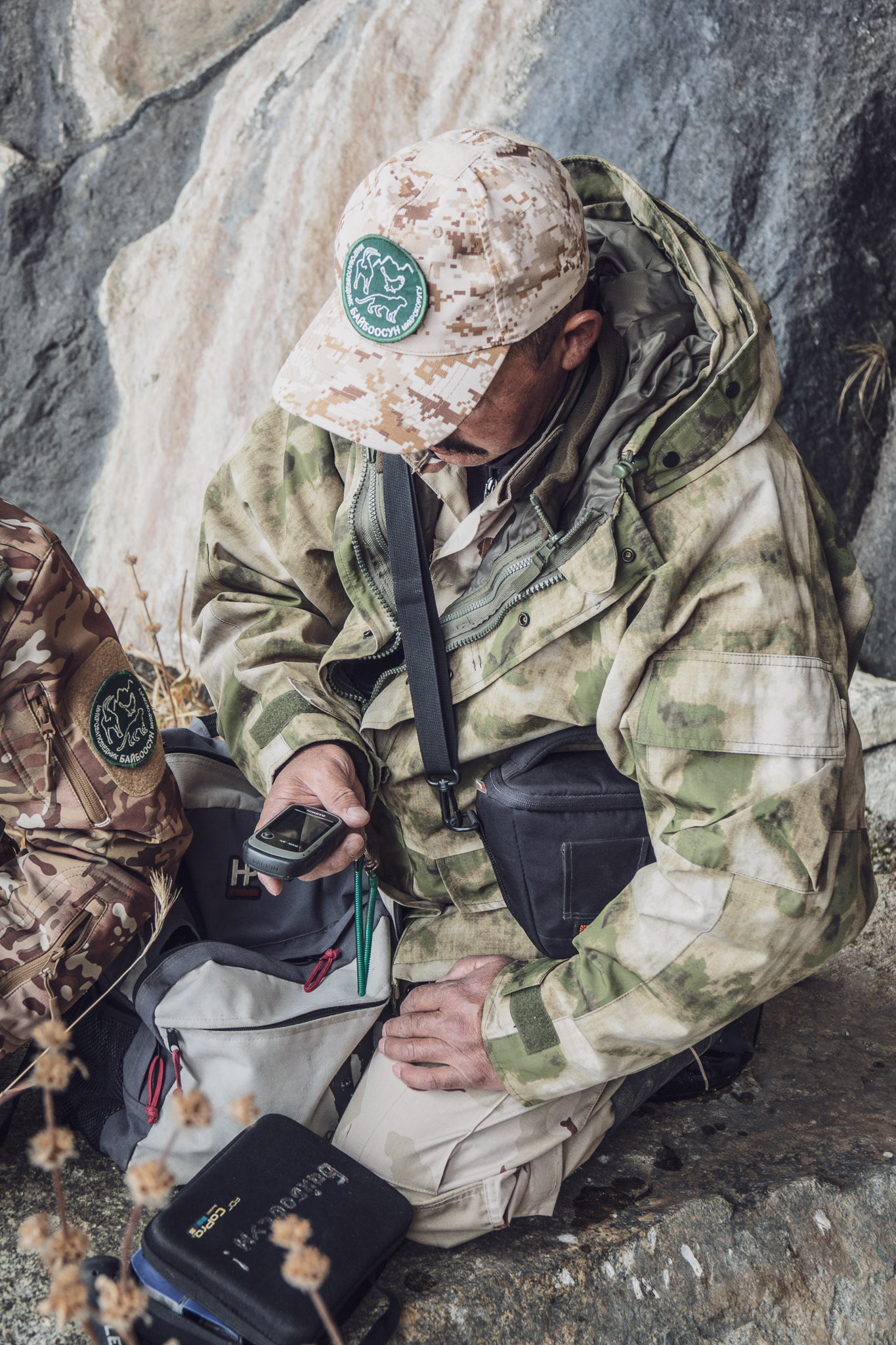
︎ Data collection
Data collection from the cameras at 3800 metres of altitude. The extreme weather conditions make the task a risky mission
Challenging conditions
The cameras traps at Baiboosun are located within the snow leopard landscape, with some cameras reaching 3800 metres altitude. The task of collecting the footage and data involves a high level of risk for our team because of this.
The cameras traps at Baiboosun are located within the snow leopard landscape, with some cameras reaching 3800 metres altitude. The task of collecting the footage and data involves a high level of risk for our team because of this.
Because of the remote location where the cameras are installed, as well as the unpredictably harsh climate in these high mountains, only the most experienced members of our team can perform this task.
We are currently looking for funding to upgrade our camera trap system. We are open to partnering with organizations in the field of technology for conservation, and also private companies and individuals, who would like to make a difference by helping us protect the unique wildlife here in the Tien-Shan mountains.
︎ Data collection
Data collection from the cameras at 3800 metres of altitude. The extreme weather conditions make the task a risky mission
Challenging conditions
The cameras traps at Baiboosun are located within the snow leopard landscape, with some cameras reaching 3800 metres altitude. The task of collecting the footage and data involves a high level of risk for our team because of this.